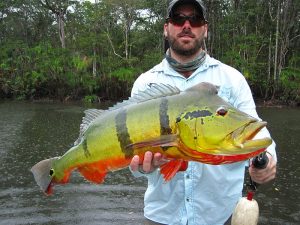About Peacock Bass

With a great video at the end, you don’t want to miss it. The Peacock Bass is not closely related to the much more popular (in the USA) Largemouth or Smallmouth Bass, but are becoming a sought-after game fish in the US, mainly in Southern Florida due to their inability to tolerate colder climates. They are also a very predatory fish feeding on the smaller native fish wherever they have been stocked.
According to Wikipedia, the Peacock Bass are native to the Amazon and Orinoco basins, as well as rivers of the Guianas, in tropical South America.
They are also known to be daylight feeders, so if you want to catch one you should probably avoid night-fishing since Peacock Bass has not been observed feeding at night.
Will Peacock Bass Fishing Get Popular In The USA?
Peacock Bass are great fighters and take some skill to catch them regularly. As far as how popular they will get remains to be seen, but we don’t think they will ever become as popular as catching Largemouth or Smallmouth Bass. The biggest reason we make that assumption it due to their intolerance of colder climates. This severely limits the geography of finding them. They die-off when the water gets cold, so you will never see them in even moderate climates. Most of the Peacock Bass stocked in Texas and places north of Miami Florida have died off due to water temperature changes.
Tips For Catching Peacock Bass
First of all, forget about fishing at night. As mentioned earlier, they do not feed at night. Start at sunrise, end at sunset. They also tend to school up more in the fall than any other time. Sometimes you will see them exploding on the surface. If not, you can cast into open water coves, lakes or ponds with topwaters, crankbaits, or plastic jerkbaits to cover more water and find them. Our understanding is that they love topwater baits the most. Poppers work well, but prop baits are also known to get them biting. Another method is to fish the edges of coral rocks and do a little sight fishing. Throw a small jig from 3/16ths to 3/8ths and if they don’t bite just keep on throwing it their way and eventually they will bite. They are also not picky when it comes to color, almost any color works well. They love bright colors like red, yellow, orange, and pearl, and dark colors like black, brown, and dark watermelon. All of the lures below are good in any colors. Don’t forget about the spawn, it can be anytime from April through September. It really depends on the conditions of the winter, spring and summer. Whether it was harsh or mild. The most likely time is from May through July. During the spawn, you can usually go sight fishing and they are very aggressive during that time.
[azon_inpost asin=”B00CQSZCBG” tpl=”tpl_4″]Heddon Chug’n Spook Junior Fishing Lure, Foxy Shad[/azon_inpost]
More From the USGS website

Means of Introduction: Peacock cichlids have been stocked by state agencies as a sport fish. The Florida Game and Fresh Water Fish Commission obtained breeding stock from several regions of South America. The progeny were released into open waters primarily as a sport fish, but also with the hope that it would prey on and thus control other introduced cichlids (Courtenay and Robins 1989; Shafland 1995). About 10,000 juveniles were released in the Fort Lauderdale area of Dade County, Florida, in 1964 (Moe 1964), but apparently those fish did not survive the cold winter of 1964-1965 (Courtenay et al. 1974; Courtenay and Robins 1989). More recent introductions into canals in Broward and Miami-Dade counties, starting in late 1984, resulted in established populations (Larsen 1993; Shafland 1995). The Hawaiian Division of Fish and Game obtained their broodstock from an aquatic supply dealer in New York, ca. 1957 (Kanayama 1968). These fish reportedly came from Guyana (Larsen 1993). The first Texas populations were released by the Texas Parks and Wildlife Department in 1978. Texas stock came from Colombia and possibly Brazil, and from the Florida Game and Fresh Water Fish Commission. The single fish reported from Arizona was likely an aquarium release or illegal stocking, as no authorized stocking of this fish has occurred in that state.
See full story on usgs.gov
